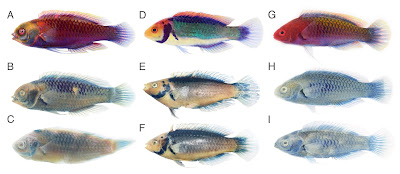 |
| Cirrhilabrus aquamarinus Tea, Allen & Dailami, 2021 DOI: 10.1643/i2021022 |
Abstract
The labrid fish Cirrhilabrus solorensis was first described in 1853 by Bleeker, based on specimens collected from the Indonesian island of Solor, off the eastern tip of Flores in the Lesser Sunda Islands. Although sufficient at the time, Bleeker's description of the species was brief, resulting in subsequent taxonomic confusion concerning the true identity of this taxon. Presently, the name has been applied to several fishes with notable differences in coloration, particularly in the terminal males. On the basis of additional non-type material and photographic examination of Bleeker's holotype, we redescribe Cirrhilabrus solorensis and resolve the long-standing contention regarding its taxonomic identity. In doing so, we describe two species as new, Cirrhilabrus aquamarinus, new species, on the basis of the holotype and eight paratypes from Sulawesi and the surrounding islands of Banggai and Wakatobi, Indonesia, and Cirrhilabrus chaliasi, new species, described on the basis of the holotype and nine paratypes from Bali, Indonesia. These three species are closely related and, together with C. aurantidorsalis, C. cyanopleura, C. luteovittatus, C. randalli, and C. ryukyuensis, form a complex of species that differ from congeners in having the following combination of characters: caudal fin in males weakly rhomboidal; median fins hyaline with sinuous filigree in both sexes; body with scales edged in inky blue to indigo, their margins often patterned in an argyle motif; and osseus elements that preserve blue to blue-green in alcohol. We briefly discuss the phylogenetic relationships of species in this complex based on results of a companion study detailed elsewhere.
Cirrhilabrus solorensis Bleeker, 1853
Solor Fairy Wrasse
Etymology.—Named after the type location of the species,
Lawajong, Solor Island, Indonesia.
Cirrhilabrus aquamarinus, new species
Chin-strap Fairy Wrasse
Habitat and distribution.— Cirrhilabrus aquamarinus occurs primarily in eastern Sulawesi and the surrounding islands of Banggai and Wakatobi. Rare individuals have also been reported from Banda Neira. The species frequents shallow exposed rubble at depths between 5–20 m (Fig. 5F).
Etymology.— The specific epithet is given after the brilliant teal to aquamarine males, an unusual color shared with no other species of Cirrhilabrus. The common name alludes to the chin-strapped appearance formed by the intensely pigmented opercular scales of the males.
Cirrhilabrus chaliasi, new species
Ruby-headed Fairy Wrasse
Habitat and distribution.— Cirrhilabrus chaliasi is known from
Bali, Sumbawa, Lombok, Flores, Komodo, and Rinca. It is also
reported from Wakatobi, Sulawesi, where it overlaps with C.
aquamarinus, though this appears to be a rare distribution record. It frequents the same habitat as other species in its
complex, consisting of rubble zones with sporadic coral cover
at depths between 8–20 m.
Etymology.—The specific epithet is given in honour of
Vincent Chalias, a skilled underwater photographer, field
biologist, and proponent of coral and fish aquaculture in
Bali. He greatly assisted in the description of the new species
through his excellent underwater photographs and detailed
field observations.
Yi-Kai Tea, Gerald R. Allen and Muhammad Dailami. 2021. Redescription of Cirrhilabrus solorensis Bleeker, with Description of Two New Species of Fairy Wrasses (Teleostei: Labridae: Cirrhilabrus). Ichthyology & Herpetology. 109(3); 669-684. DOI: 10.1643/i2021022












